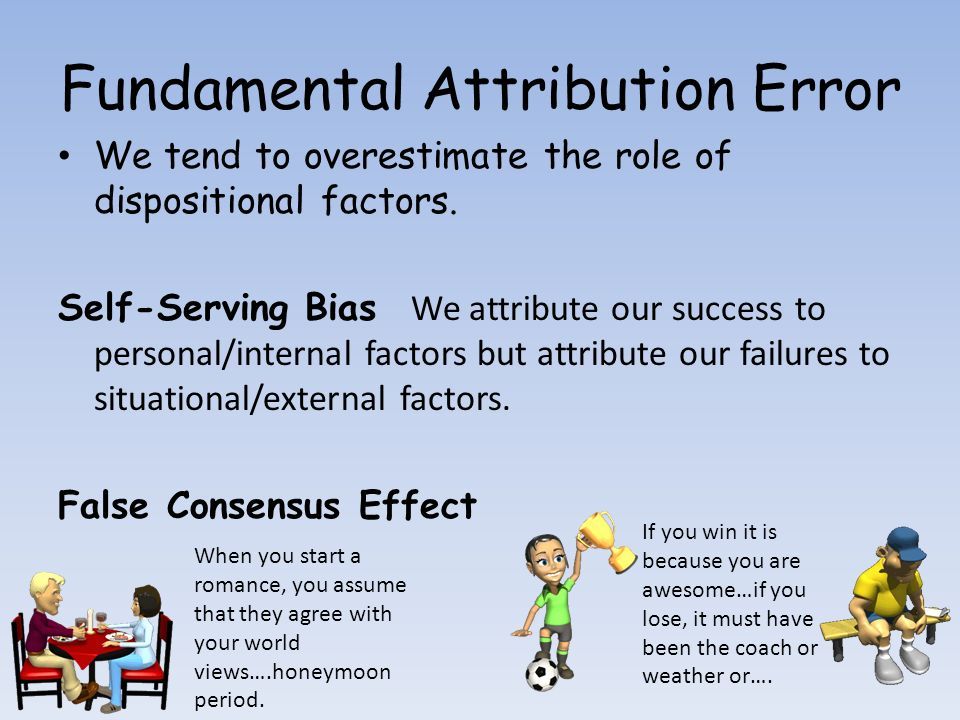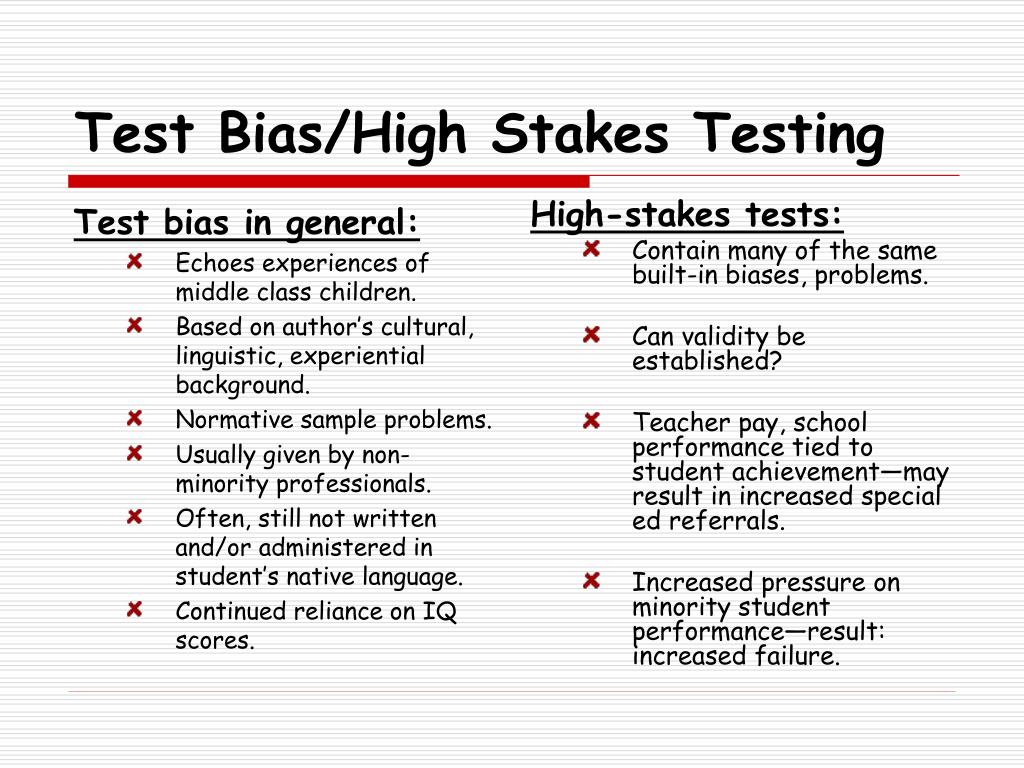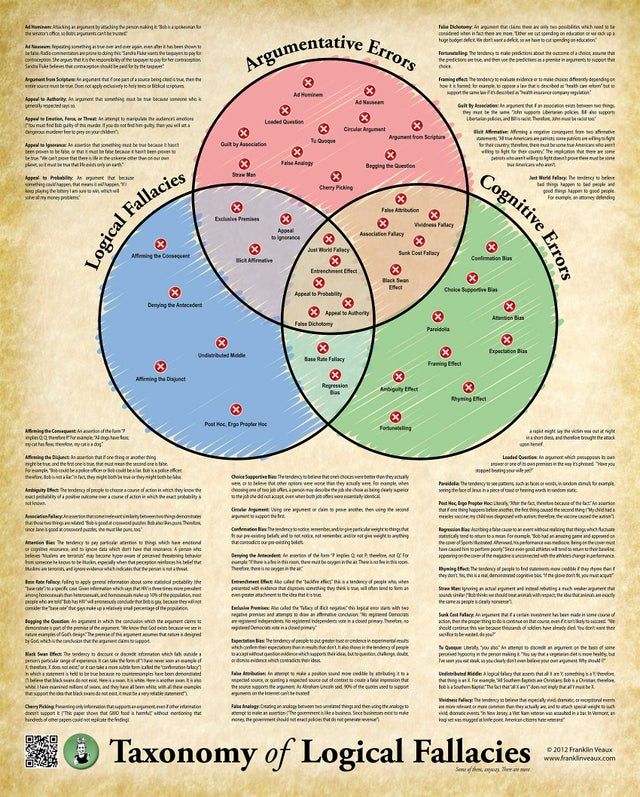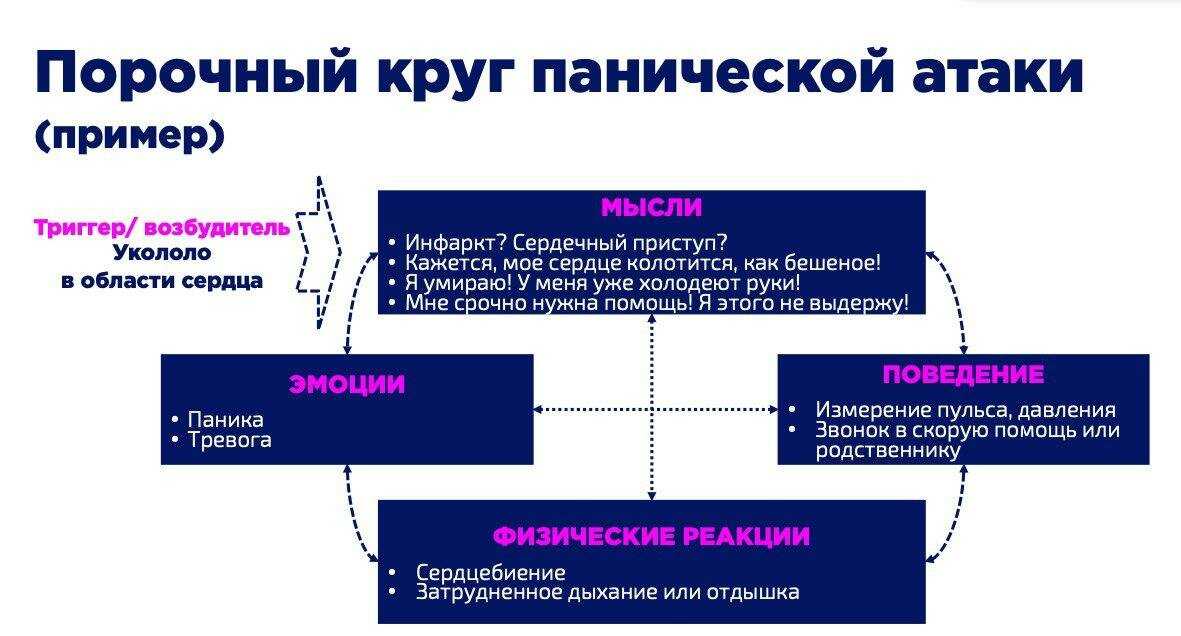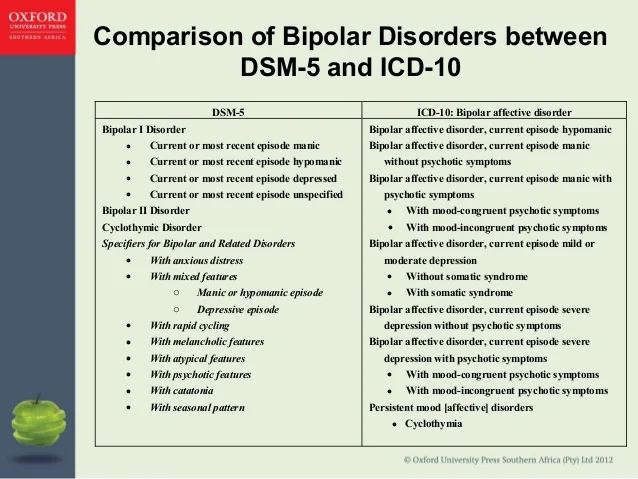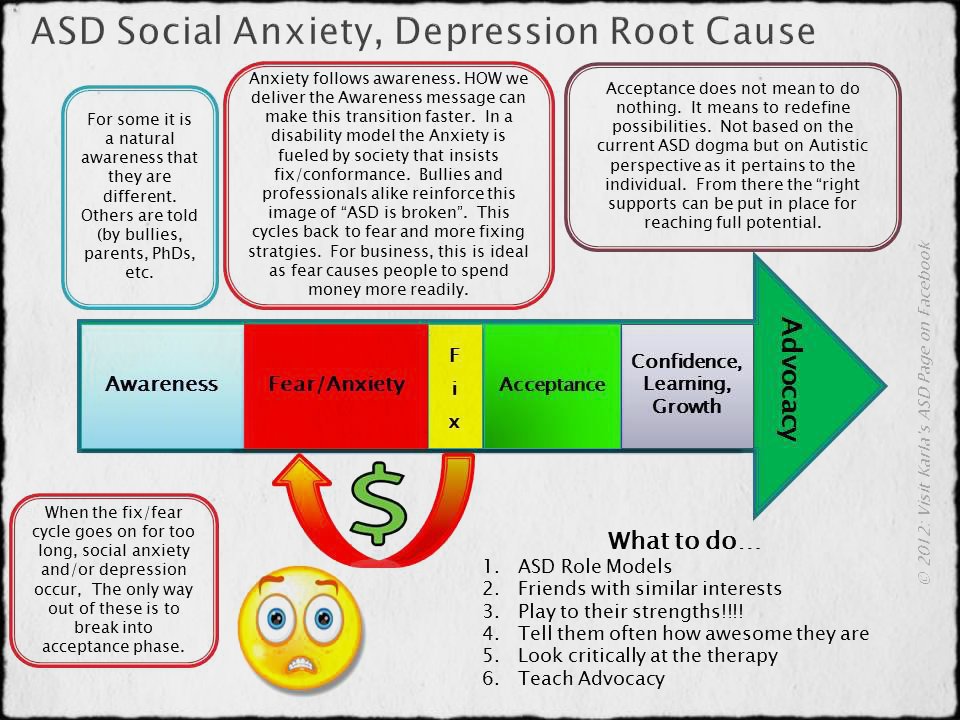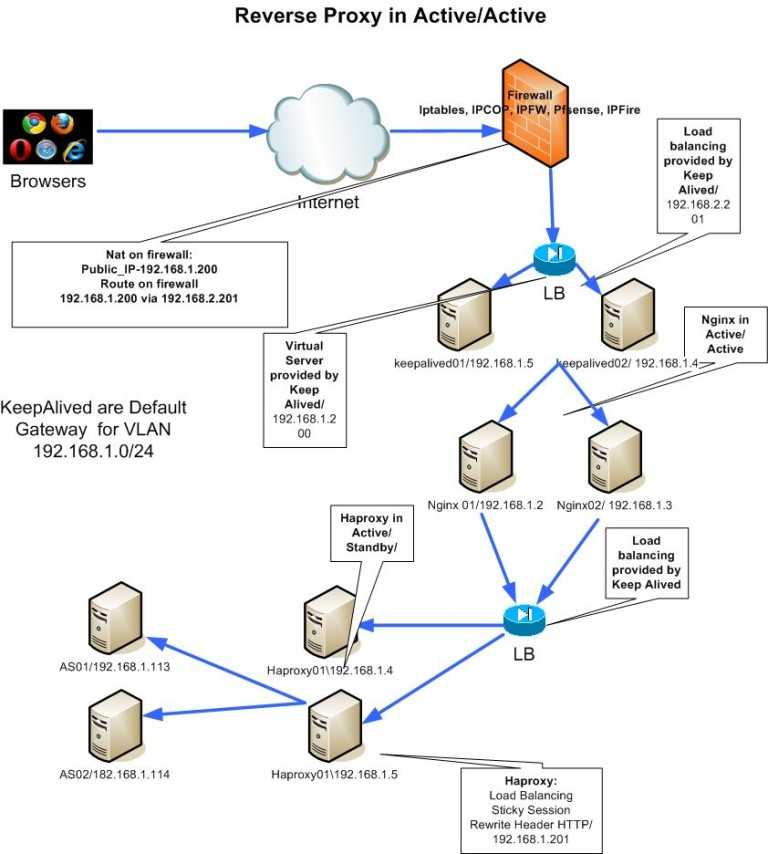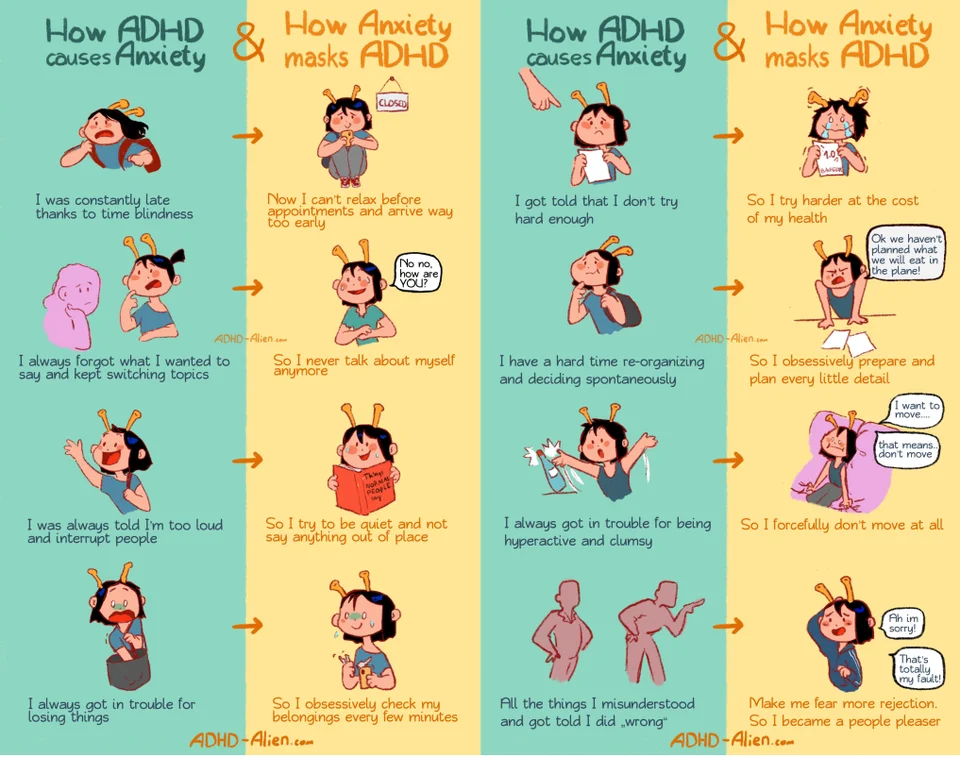Examples of attribution bias
Attribution Bias: What is Attribution Bias?
Attribution bias is the tendency to explain a person’s behaviour by referring to their character rather than any situational factor. In essence, it leads us to overestimate the weight of someone’s personality traits, and underestimate the influence of their individual circumstances. Still confused? Read on for some examples as we delve deeper into this unconscious bias.
Attribution bias examples
Example #1
Situation – You’re driving along the motorway and another car cuts in front of you in an erratic, haphazard way.
Biased interpretation – You might draw some conclusions about the other driver’s character based on their poor driving. Perhaps you think they’re rude, arrogant, or aggressive.
Reality – What you don’t know, however, is that the driver is speeding to the A&E department following a serious accident. They’re driving badly because they’re injured.
Example #2
Situation – When eating out with a group, one of your friends leaves a large tip for the restaurant.
Biased interpretation – You may think that your friend is inherently generous for leaving the tip.
Reality – What you don’t know, is that your friend is actually trying to impress the rest of the group by giving a large tip.
Example #3
Situation – A teacher asks one student to be a ‘quizmaster’, and devise 5 questions from his own knowledge to pose to another student in the class. The other student only gets 1 question correct. The teacher then asks the rest of the class ‘who do you think is more intelligent?’
Biased interpretation – The class responds that the quizmaster is more intelligent, based solely on the fact that he knew the answers (to the questions that he made!).
Reality – There’s no actual evidence in this scenario which indicates the intelligence of either the quizmaster or the student.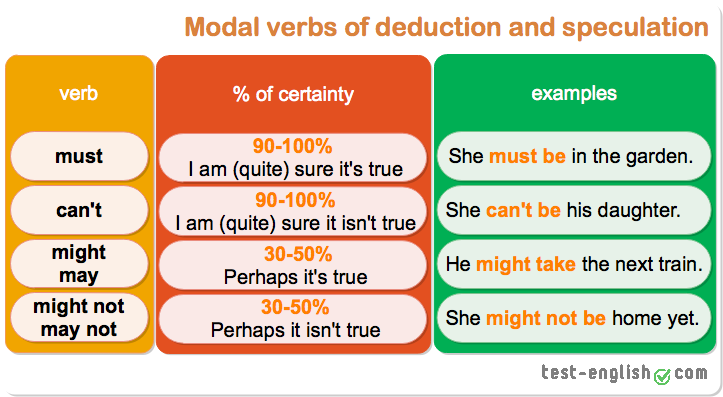 The class based their assumption on the limited and flawed data that they had to hand, which was ‘who knew the most answers’.
The class based their assumption on the limited and flawed data that they had to hand, which was ‘who knew the most answers’.
(N.B – This example was actually an experiment conducted at the University of Illinois)
Different types of attribution bias
As you can see from the above examples, the main characteristic of attribution bias is ‘perceptual error’. When we don’t have the full picture of a situation, we use the information we do have to draw conclusions – and these are often related to people’s character and are usually unfounded. Whilst this is the crux of attribution bias, there are a number of variants, including:
Ultimate attribution error – Attribution bias on a group-level. It’s the belief that positive acts committed by our own ‘group’ are the result of ‘good’ personality traits. Inversely, positive acts committed by other groups are considered more as the result of situational factors.
Hostile attribution bias – The idea that we interpret ambiguous behaviour as outwardly hostile.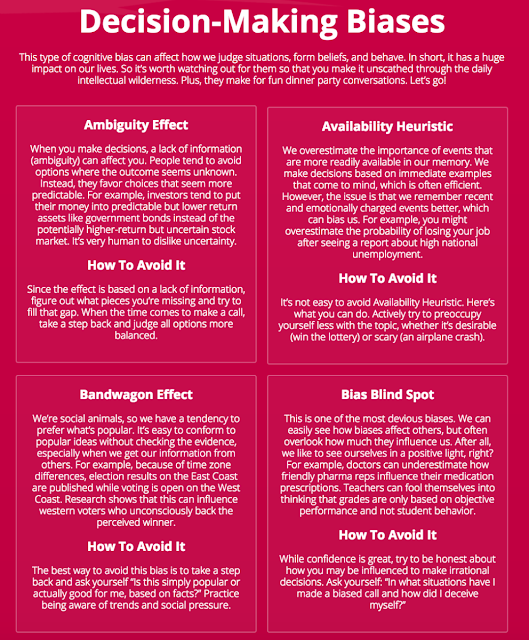 Whispering, for example, is seen as malign despite a lack of evidence to suggest so.
Whispering, for example, is seen as malign despite a lack of evidence to suggest so.
Self-serving bias – Similar to ‘meritocratic hubris’. This is the belief that one’s own successes are the direct result of their character and abilities, rather than luck or other situational factors. Equally, self-serving bias leads us to assign blame for our failures to external rather than internal causes.
Attribution bias and hiring
Attribution bias can clearly influence many aspects of our lives. One area where it’s particularly prominent, however, is the world of work. Attribution bias can creep into the recruitment process, leading employers to hire people based on factors that aren’t necessarily linked to their skills.
CVs, for example, have been proven not to be indicative of a candidate’s ability. When a recruiter sees the grades of a candidate, they will make assumptions about that candidate’s skills – for better or worse.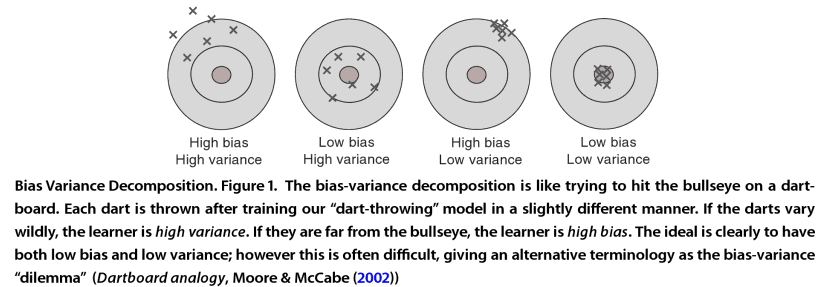 This is a case of attribution bias.
This is a case of attribution bias.
Rather than trawling through out-dated CVs that only serve to trigger our unconscious bias, employers should use work samples instead. By setting candidates tasks that simulate the day-to-day job and anonymising them, companies give themselves the best chance to hire the most able candidate regardless of where they’re from or what they’ve done. They’re also more likely to stay for the long term.
Applied is the essential recruitment platform for fairer hiring. Purpose-built to make hiring ethical and predictive, our platform uses anonymised applications and skills-based assessments to improve diversity and identify the best talent.
Start transforming your hiring now: book in a demo or browse our ready-to-use, science-backed talent assessments.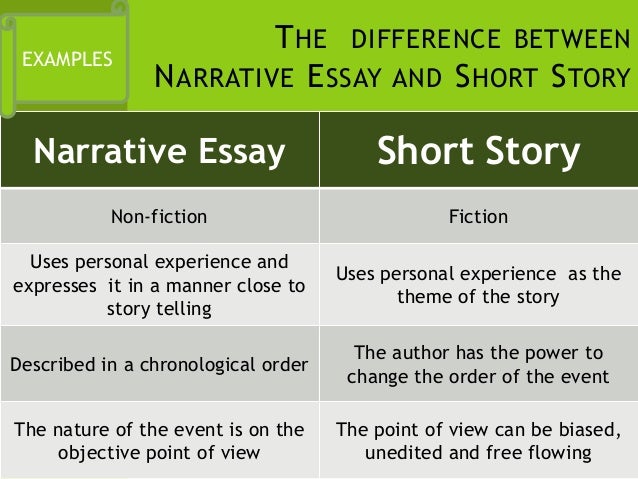
What It Is & How to Avoid It
There's been a lot written about cognitive biases in the last decade. If you walk into the Psychology section of Barnes of Noble today or browse Amazon for "decision-making," you're sure to see a library of books about how irrational humans can be.
Many cognitive biases affect humans and their everyday actions, like confirmation bias and overconfidence. But the most important, and troubling, error that professionals tend to make in their thinking may be the fundamental attribution error.
Cognitive biases such as these often shape how an individual interacts with the world around them. In the world of business, understanding these biases and becoming aware of the ways that they influence your behavior is vital to becoming a better manager.
What Is the Fundamental Attribution Error?
The fundamental attribution error refers to an individual's tendency to attribute another's actions to their character or personality, while attributing their behavior to external situational factors outside of their control. In other words, you tend to cut yourself a break while holding others 100 percent accountable for their actions.
In other words, you tend to cut yourself a break while holding others 100 percent accountable for their actions.
For instance, if you've ever chastised a "lazy employee" for being late to a meeting and then proceeded to make an excuse for being late yourself that same day, you've made the fundamental attribution error.
The fundamental attribution error exists because of how people perceive the world. While you have at least some idea of your character, motivations, and situational factors that affect your day-to-day, you rarely know everything that's going on with someone else. Similar to confirmation and overconfidence biases, its impact on business and life can be reduced by taking several measures.
Fundamental Attribution Error Examples
It's clear to see how the fundamental attribution error (FAE) can impact your personal life, but it's important to recognize the influence it can have on your work, as well. Whether you're an employee or manager, cognitive biases, like the FAE, can play a role in how you interact with others in the workplace and how you make key business decisions.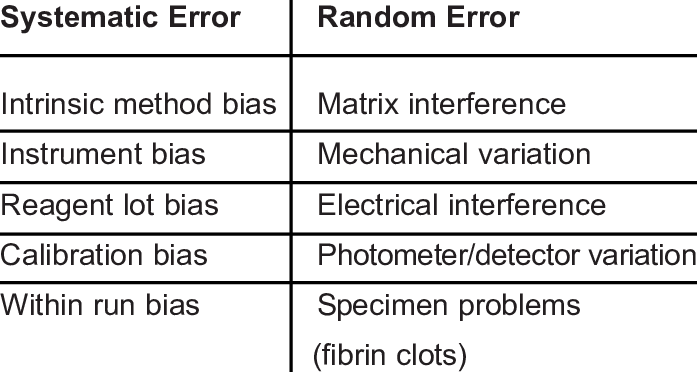
In working with your colleagues, for example, you probably form a general impression of their character based on pieces of a situation, but never see the whole picture. While it would be nice to give them the benefit of the doubt, your brain tends to use limited information to make judgments.
Within organizations, FAE can cause everything from arguments to firings and ruptures in organizational culture. In fact, it's at the root of any misunderstanding in which human motivations have the potential to be misinterpreted.
For example, think back to the "lazy employee." Since she was late to an important meeting, you might be inclined to form a judgment of her character based on this one action alone. It's possible, however, that her behavior is due to several external, rather than internal, factors. For instance, any number of situational factors could have caused her to run behind schedule, such as a family emergency or traffic jam, which have nothing to do with the quality of her character.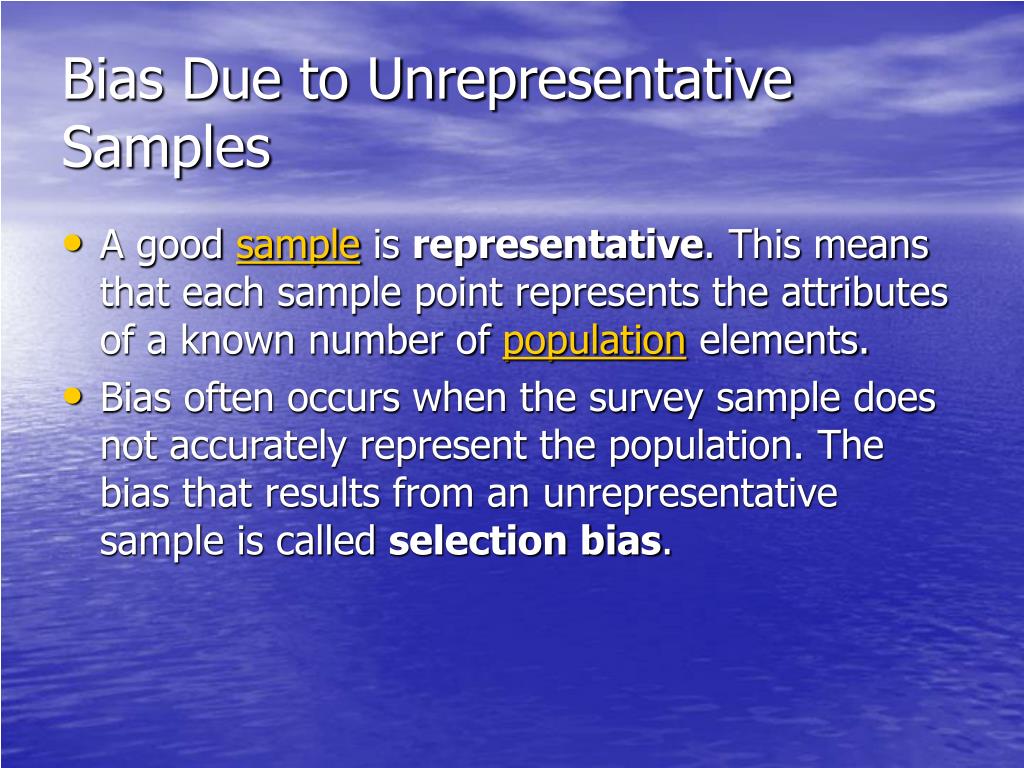
In action, forming impressions of a person's character based on limited information can have long-lasting effects. Now that you perceive this person as "lazy," your opinions of her may begin to shift over time. Unless the opportunity arises for you to get to know your employee better, you may always view her in a negative light.
How to Avoid the Fundamental Attribution Error
Think of the last time you thought a co-worker should be fired or a customer service representative was incompetent. How often have you really tried to understand the situational factors that could be affecting this person's work? Probably not often.
The fundamental attribution error is so prevalent because it's rooted in psychology, so completely overcoming it can be difficult. One tool that can be helpful in combating FAE is gratitude. When you become resentful at someone for a bad "quality" they demonstrate, try to make a list of five positive qualities the person also exhibits. This will help balance out your perspective and can help you view your co-worker as a whole person instead of through the lens of a single negative quality.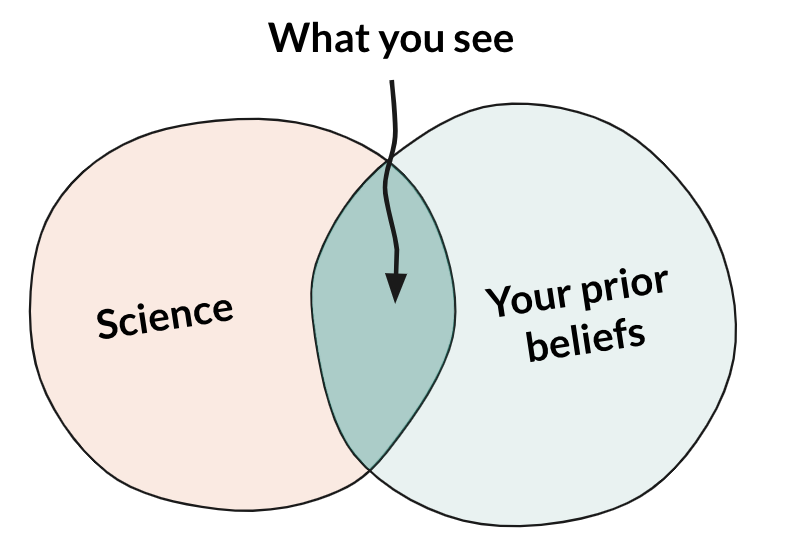
Another method is to practice becoming more emotionally intelligent. Emotional intelligence has become a buzzword in the business world over the past 20 to 30 years, but it involves practicing self-awareness, empathy, self-regulation, and other methods of becoming more objective in the service of one's long-term interests and the interests of others. Practicing empathy, in particular, such as having discussions with co-workers about their opinions on projects and life out of the office, is a good first step.
FAE is impossible to overcome completely. But with a combination of awareness and a few small tools and tactics, you can be more gracious and empathic with your co-workers. In fact, being able to acknowledge cognitive biases like FAE and make the conscious effort to limit their effects is an essential component of becoming a better manager.
Are you interested in improving your managerial skills? Explore our eight-week online course Management Essentials and gain the skills and strategies to excel in decision-making, implementation, organizational learning, and change management.
This post was updated on February 14, 2020. It was originally published on June 8, 2017.
7 examples of self-bias you see throughout your life
When something good happens, people tend to think, "I worked so hard, I'm so talented, I did a great job!". But when something goes wrong, people often begin to mentally consider any external factors that might be to blame. Can you remember a time when you quickly conceded victory but were looking for other possible reasons when something went wrong? I can remember a few.
Today we're going to look at a cognitive bias that offers some explanation for why we tend to do things the way we do. And we will talk about this with Artyom Ginevsky - a blogger, author and leader of the marathon to achieve the goals of "Achiever".
Artyom Ginevsky : Self-serving bias is very common and it is important to be aware of it so that you can make an honest and comprehensive assessment when you do not achieve the expected results.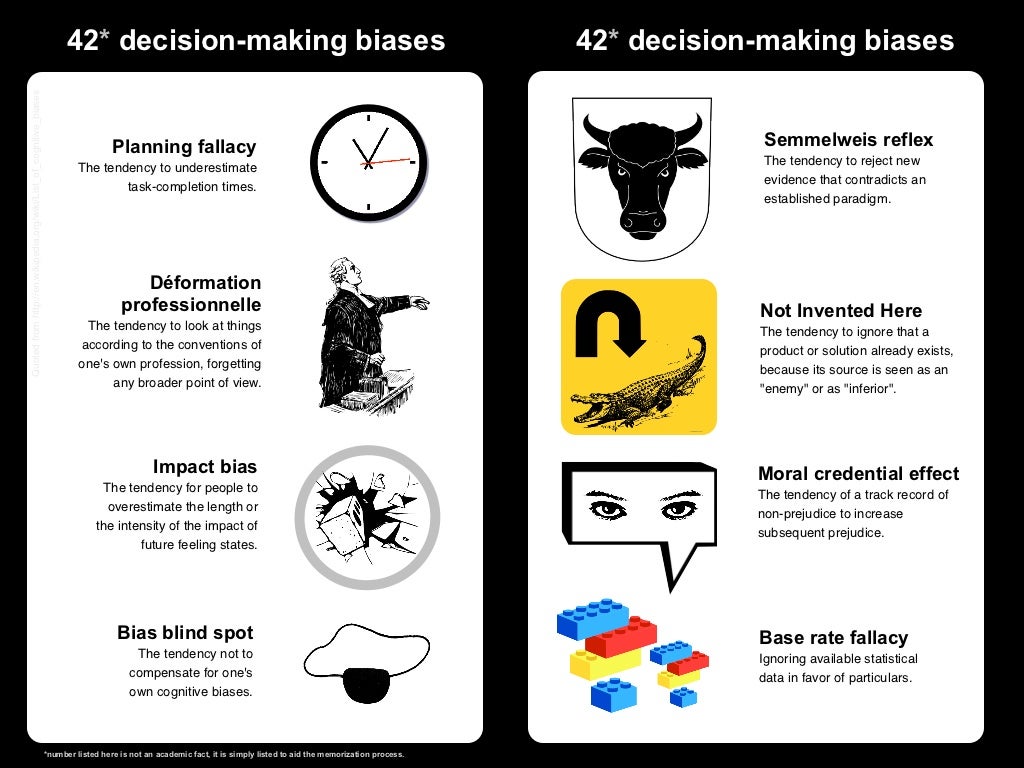 Let's first look at the detailed definition of self-serving bias and why it's important to be aware of it, and then look at some examples of when you might encounter it in your daily life. nine0003
Let's first look at the detailed definition of self-serving bias and why it's important to be aware of it, and then look at some examples of when you might encounter it in your daily life. nine0003
What is selfish bias towards oneself?
Artyom Ginevsky: Simply put, self-serving bias is a mindset in which people attribute positive outcomes to internal factors (such as talent and hard work) and negative outcomes to external factors (such as bad luck or task difficulty). The self-serving bias stems from a broader social psychology concept known as causal attribution, which refers to how we interpret and explain the causes of everyday events. Social psychologist Fritz Heider postulated attribution theory, which explains that people either attribute their results to ability and effort (internal) or to hardship and luck (external). Interestingly, research shows that self-interest is much more common in our competitive Western culture, where our self-esteem is often closely tied to our success or failure, while it is less common in Eastern cultures, where people tend to attribute success to luck. or occasion. People link outcomes in a way that serves their interests. nine0003
or occasion. People link outcomes in a way that serves their interests. nine0003
People do this for three reasons (besides cultural and demographic factors): Self-respect: Recognizing our successes and blaming others for our failures protects us from criticism. The selfish bias distorts how we perceive ourselves, allowing us to believe that we can't do anything wrong, thus preserving our self-worth. Self-presentation: We like to present ourselves in a positive way in order to promote a certain image of ourselves, whether it is self-defined or customized according to society's preferences and expectations. In addition, our self-esteem is influenced by other people's opinion of us, so we act favorably in order to maintain a socially desirable image that helps us feel good about ourselves. Optimism: Humans are inherently optimistic, meaning that negative outcomes are usually unexpected. This prevents us from associating negative results with personal causes. nine0003
Why is this cognitive bias important?
Artyom Ginevsky: While this common prejudice may seem harmless, it's important to be aware of it and its potential impact on your life. Recognizing this bias can help you recognize important mistakes that lead to adverse outcomes. After all, if you don't admit your mistakes, you won't be able to learn from them or correct them in the future. As we know, a big part of success is learning from your failures and then making improvements accordingly. But you will never get better if you don't know what you need to work on. The selfish bias certainly allows us to protect our self-esteem, but after we continually miss the opportunity to correct our own shortcomings, we become accustomed to looking at external factors to identify shortcomings. You will notice - especially in the first example below - how this fallacious reasoning is not malice. People sincerely turn away from the internal search for possible mistakes and assume that their failure is the result of something else. So when you are aware of the self-interest bias, you are less likely to inadvertently maintain this narrow mindset. nine0003
Recognizing this bias can help you recognize important mistakes that lead to adverse outcomes. After all, if you don't admit your mistakes, you won't be able to learn from them or correct them in the future. As we know, a big part of success is learning from your failures and then making improvements accordingly. But you will never get better if you don't know what you need to work on. The selfish bias certainly allows us to protect our self-esteem, but after we continually miss the opportunity to correct our own shortcomings, we become accustomed to looking at external factors to identify shortcomings. You will notice - especially in the first example below - how this fallacious reasoning is not malice. People sincerely turn away from the internal search for possible mistakes and assume that their failure is the result of something else. So when you are aware of the self-interest bias, you are less likely to inadvertently maintain this narrow mindset. nine0003
1. Victory / defeat. A person's performance in a sport is so closely related to a particular outcome that players often exhibit a self-serving bias. This is especially true in individual sports where there is a clearly defined single winner of the game. When an athlete wins a game, they are more likely to applaud themselves for their talent, practice, and dedication to their chosen sport. But if they lose the game, they may start questioning the referees' decisions. Comprehensive meta-analysis 69A 2020 study analyzing 10,515 athletes found that sports players exhibit a self-serving bias due to their tendency to attribute success to personal factors and failure to external factors.
A person's performance in a sport is so closely related to a particular outcome that players often exhibit a self-serving bias. This is especially true in individual sports where there is a clearly defined single winner of the game. When an athlete wins a game, they are more likely to applaud themselves for their talent, practice, and dedication to their chosen sport. But if they lose the game, they may start questioning the referees' decisions. Comprehensive meta-analysis 69A 2020 study analyzing 10,515 athletes found that sports players exhibit a self-serving bias due to their tendency to attribute success to personal factors and failure to external factors.
2. Bad test results. A self-interested bias can help students maintain a sense of pride in their hard work after getting a good test score, as they can attribute their success to their learning habits and subject knowledge. However, the same acknowledgment of responsibility may not be available if the examination result is lower than expected.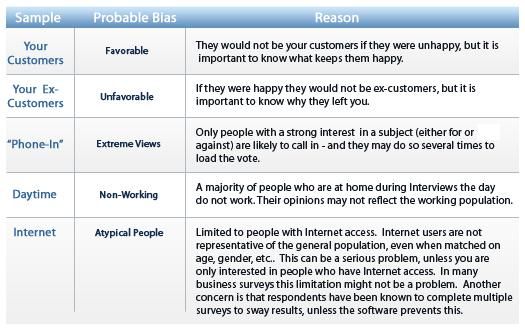 After receiving a low grade, the student may remember that the test was unfair or poorly written. Or maybe the student even perceives the questions as irrelevant to the material being taught. This does not mean that the student is being dishonest - in fact, she could devote herself to studying the material. But the student could use faulty logic when the thought of her inadequate study did not occur. nine0003
After receiving a low grade, the student may remember that the test was unfair or poorly written. Or maybe the student even perceives the questions as irrelevant to the material being taught. This does not mean that the student is being dishonest - in fact, she could devote herself to studying the material. But the student could use faulty logic when the thought of her inadequate study did not occur. nine0003
3. Teachers. As it turns out, research has shown that just like students, teachers can have self-serving biases when it comes to performance in their classroom. This creates the possibility of conflict between students and teachers when someone gets a bad grade because neither of them can take responsibility for a bad result. While a failing student may want to place the blame on the teacher, the teacher is more likely to hold him accountable for his own work, especially if other students get satisfactory grades. And, in turn, if the students do well, the teacher can praise himself for his excellent teaching skills. nine0003
nine0003
4. Job search. How do you feel when you get offered a job after going through an (often tedious) interview? You can trust that your experience, qualifications, accomplishments, and hard-earned interview skills have really paid off. But when you get that awful letter from a hiring manager: "We're sorry to tell you...", you might be wondering if the interviewer didn't "like" you, or didn't ask the right questions to really highlight your skills. Research shows that employment is often explained by self-interest bias, since hiring is often explained by internal factors, while leaving a position (or being fired) is explained by external factors - be it a short-term layoff. nine0003
5. At work. You can probably think of a situation in your past work experience in which you witnessed a colleague exhibit a self-serving bias, even if you didn't know there was a name for it. Self-interest often arises in professional environments because employees want to present themselves in a positive light to their superiors and co-workers. Employees want to maintain a positive reputation for being competent, knowledgeable, skilled and accurate in their work. Selfish bias often occurs at work because employees want to present themselves positively to employers and colleagues. You may have the experience of working with a colleague who is always willing to credit any positive results or seek praise from others while denying any blame when a problem arises. This may be due to self-interest bias, which can lead to a toxic work environment where the guilty employees lack the self-awareness to realize their role in the problem. However, many studies have shown that the longer the relationship between employees and their colleagues, the more people blame others for workplace failures. This means that people who work closely on a single team are less likely to blame others for poor results than, say, colleagues working virtually on a one-time project. nine0003
Employees want to maintain a positive reputation for being competent, knowledgeable, skilled and accurate in their work. Selfish bias often occurs at work because employees want to present themselves positively to employers and colleagues. You may have the experience of working with a colleague who is always willing to credit any positive results or seek praise from others while denying any blame when a problem arises. This may be due to self-interest bias, which can lead to a toxic work environment where the guilty employees lack the self-awareness to realize their role in the problem. However, many studies have shown that the longer the relationship between employees and their colleagues, the more people blame others for workplace failures. This means that people who work closely on a single team are less likely to blame others for poor results than, say, colleagues working virtually on a one-time project. nine0003
6. Working group. This cognitive bias is so prevalent in the workplace that researchers have studied how and when self-interest bias has a negative impact that negatively impacts productivity. One example the researchers found was a workplace situation involving an accident. In these cases, the injured employee is more likely to blame external factors for the incident, while bystanders usually perceive the accident as the employee's fault. This suggests that self-serving bias can manifest itself in people who do not normally rely on this method of reasoning to maintain their ego - in some cases it can materialize in rational people who are usually balanced. So how can this affect performance? If teammates have foggy judgments and fail to properly respond to (or accurately analyze) unforeseen problems that arise, their rational decision-making skills can also be compromised when confronted with significant business milestones that can impede progress of any kind. nine0003
One example the researchers found was a workplace situation involving an accident. In these cases, the injured employee is more likely to blame external factors for the incident, while bystanders usually perceive the accident as the employee's fault. This suggests that self-serving bias can manifest itself in people who do not normally rely on this method of reasoning to maintain their ego - in some cases it can materialize in rational people who are usually balanced. So how can this affect performance? If teammates have foggy judgments and fail to properly respond to (or accurately analyze) unforeseen problems that arise, their rational decision-making skills can also be compromised when confronted with significant business milestones that can impede progress of any kind. nine0003
7. Car accident. I believe that many people who have been in car accidents are reluctant to admit they are at fault - and it turns out that 75% of people who have been in an accident do believe that they are not at fault and blame the other driver from the very beginning. This comes from self-prejudice because people naturally want to protect their self-esteem and prevent them from appearing careless. In today's world, research has been done on the relationship between selfish bias in the introduction of self-driving cars. While there are encouraging expectations for reducing car accidents using autonomous vehicles, the introduction of these vehicles on a limited basis cannot eliminate accidents caused by human-driven vehicles. So while the owner of an autonomous car may have a lower risk of being at fault for a crash, they are still exposed to the threat of a crash caused by human drivers. This study looked at the concept of selfish bias in the context of drivers' propensity to own self-driving cars. A survey of 531 drivers found that as selfish bias increases, there is a perceived reduction in the risk of owning a self-driving car (because the driver never thinks they are at fault for the accident anyway), which also reduces the desire to own one of these new cars.
This comes from self-prejudice because people naturally want to protect their self-esteem and prevent them from appearing careless. In today's world, research has been done on the relationship between selfish bias in the introduction of self-driving cars. While there are encouraging expectations for reducing car accidents using autonomous vehicles, the introduction of these vehicles on a limited basis cannot eliminate accidents caused by human-driven vehicles. So while the owner of an autonomous car may have a lower risk of being at fault for a crash, they are still exposed to the threat of a crash caused by human drivers. This study looked at the concept of selfish bias in the context of drivers' propensity to own self-driving cars. A survey of 531 drivers found that as selfish bias increases, there is a perceived reduction in the risk of owning a self-driving car (because the driver never thinks they are at fault for the accident anyway), which also reduces the desire to own one of these new cars. nine0003
nine0003
How to avoid selfish bias?
Artyom Ginevsky: Although selfish bias is common, you can avoid it and reduce its impact on your daily decisions. Begin awareness to help you recognize situations in which you are subject to this prejudice, such as those described in my story. As you become aware of common cognitive biases, you will begin to notice them, which will empower you to manage yourself. Through mindfulness practice, you will also be able to identify potentially unpleasant thoughts about your guilt without judging them. You can also mitigate this bias by practicing self-compassion, which can help you reduce your defensiveness and accept constructive criticism when you are on the path to self-improvement. Self-compassion will also allow you to show kindness to yourself, especially in the face of setbacks. Researchers have found that being open to increasing self-compassion is especially beneficial for athletes. In sports, athletes who are self-compassionate have fewer negative thoughts and feelings, which helps athletes reject self-criticism and negative thoughts after they have taken a wrong step. In addition, self-compassion allows athletes to benefit from constructive criticism because they maintain realistic self-assessments and are able to recognize their weaknesses. nine0003
In addition, self-compassion allows athletes to benefit from constructive criticism because they maintain realistic self-assessments and are able to recognize their weaknesses. nine0003
Artyom Ginevsky was with us - a blogger, author and leader of the marathon to achieve the goals "Achiever". You can find more information on Artem's blog at the link: https://instagram.com/ginevsky
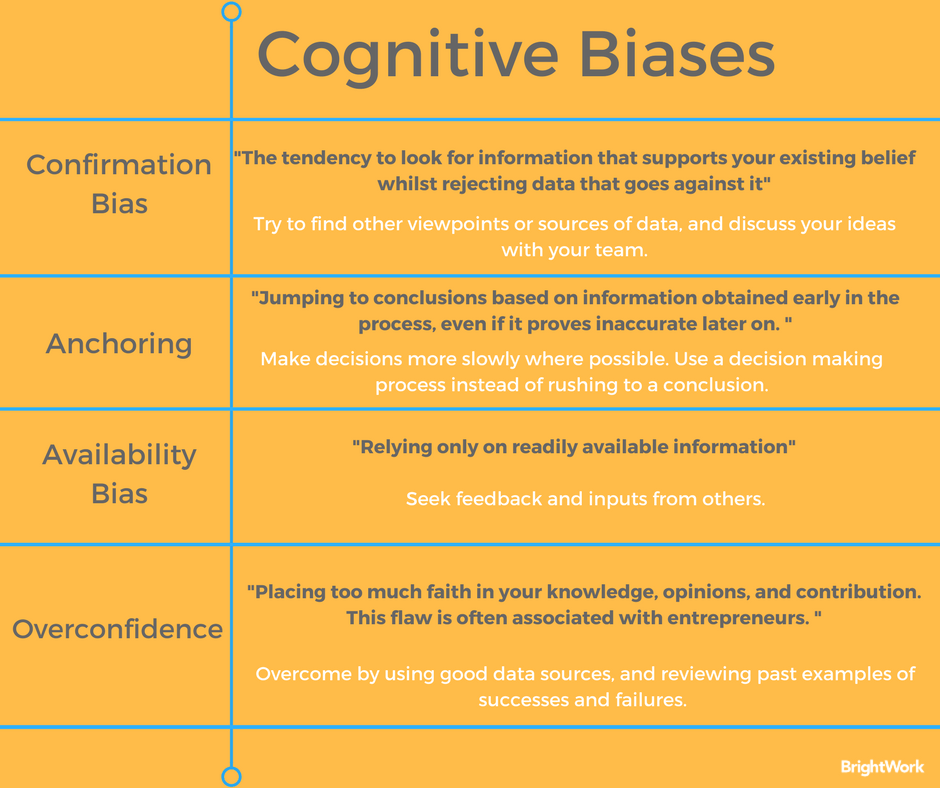 nine0055
nine0055 


 Group members try to minimize conflict and reach a consensus solution without critically evaluating alternative points of view, actively suppressing dissent and isolating themselves from outside influence. nine0055
Group members try to minimize conflict and reach a consensus solution without critically evaluating alternative points of view, actively suppressing dissent and isolating themselves from outside influence. nine0055  nine0055
nine0055 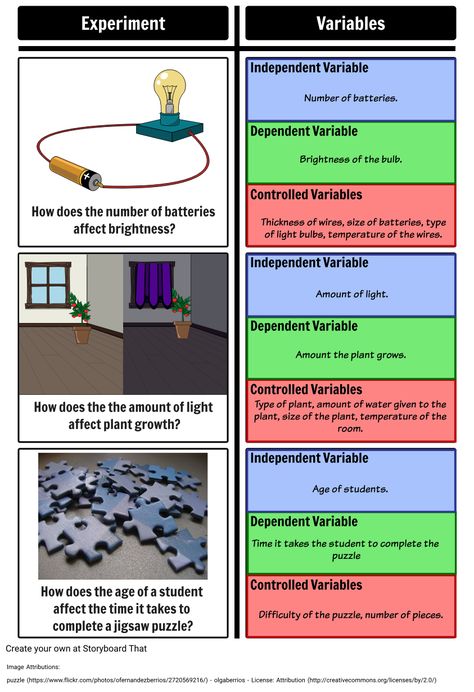
 nine0055
nine0055 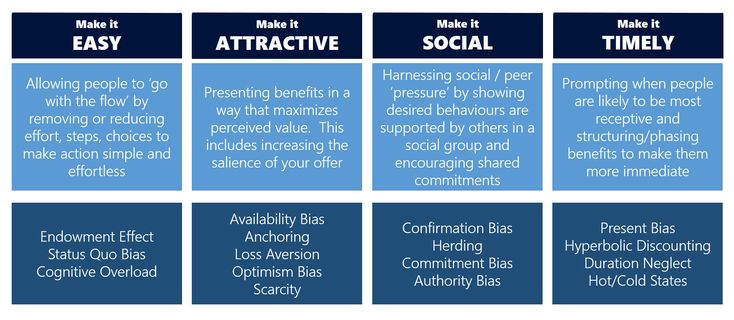
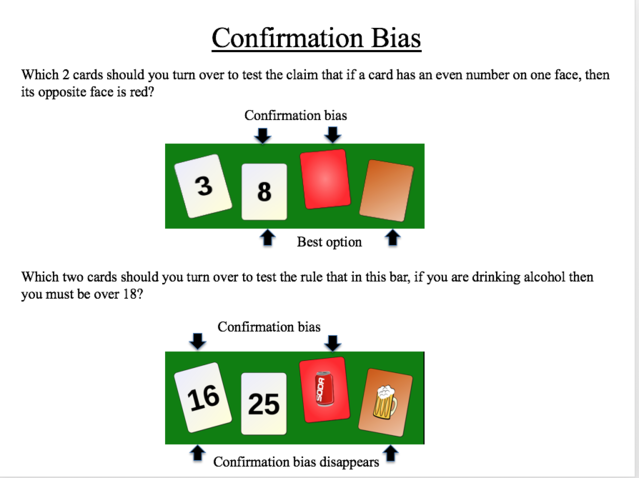
 There are many types of memory corruption, including:
There are many types of memory corruption, including: 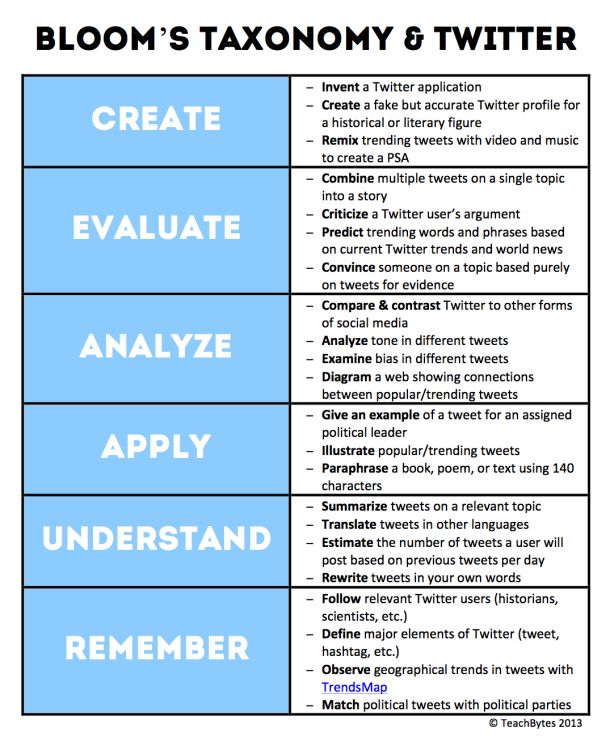 g. work-related recall time and accuracy will be lower than at home, and vice versa).
g. work-related recall time and accuracy will be lower than at home, and vice versa). 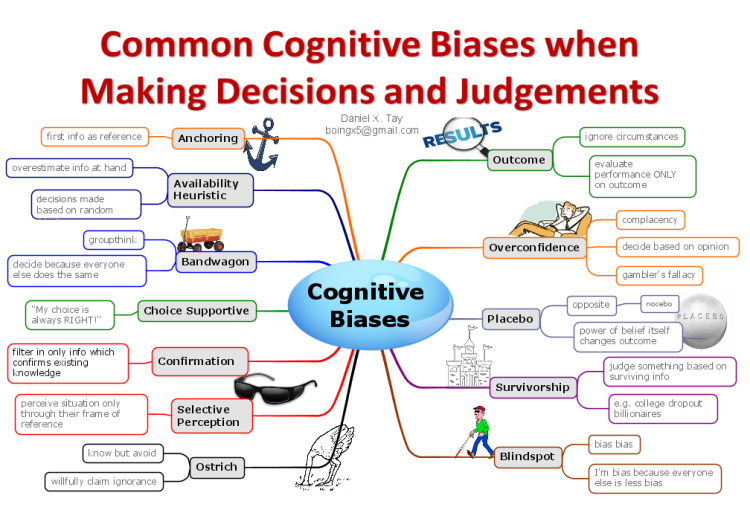 For example, people may remember statements they have made better than similar statements made by others. nine0055
For example, people may remember statements they have made better than similar statements made by others. nine0055  Both biases can increase over time, as well as repeated recall or retelling of the memory. nine0055
Both biases can increase over time, as well as repeated recall or retelling of the memory. nine0055 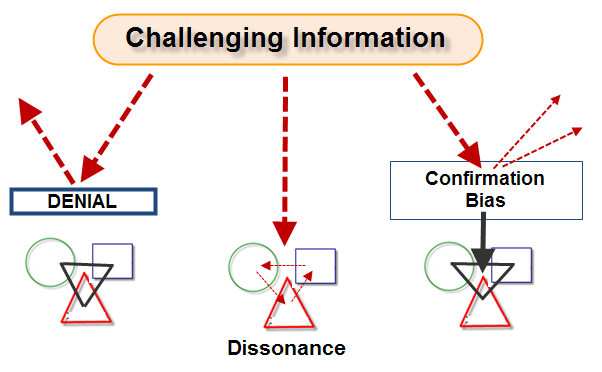

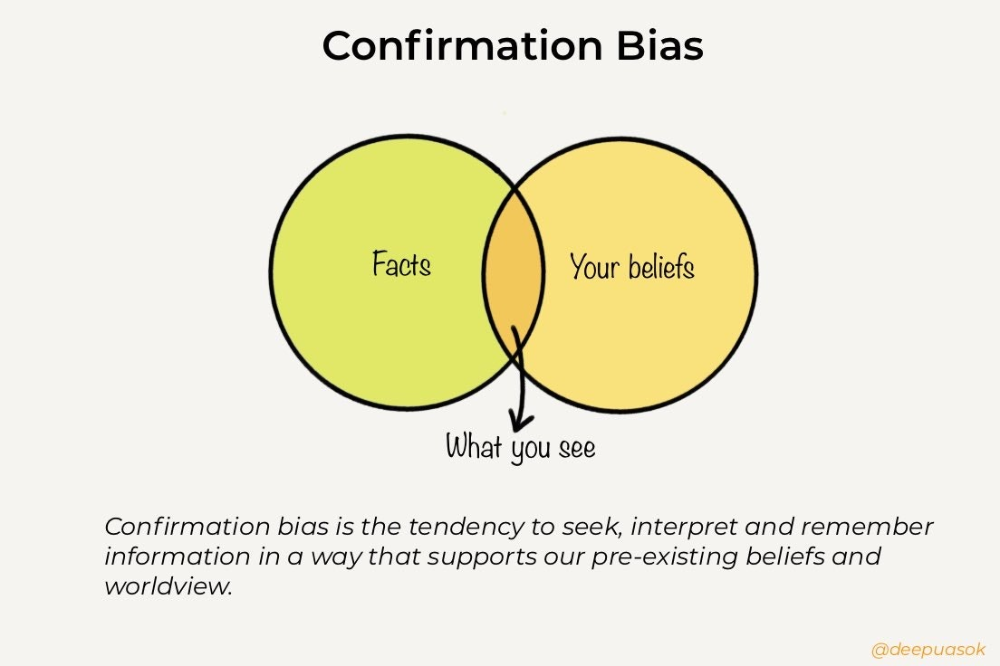 nine0055
nine0055 
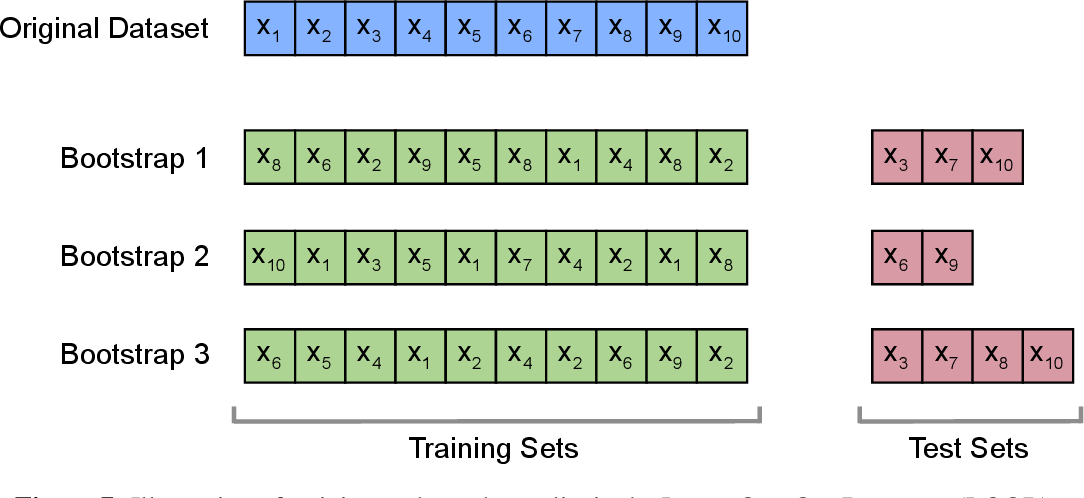 This is because memories are representations, not exact copies.
This is because memories are representations, not exact copies. 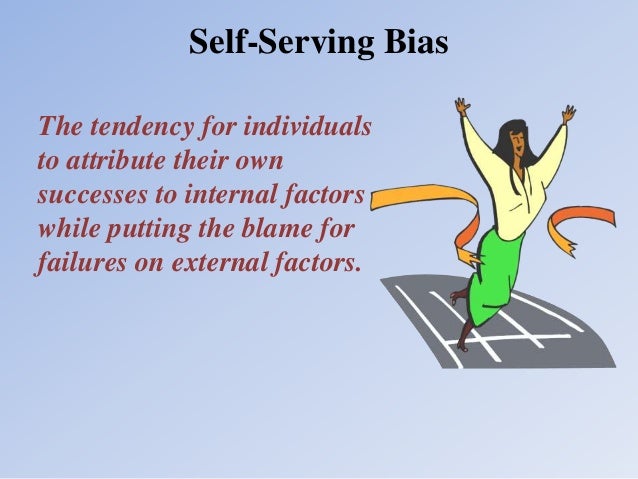 However, they cannot do this systematically, purposefully, and predictably. nine0003
However, they cannot do this systematically, purposefully, and predictably. nine0003 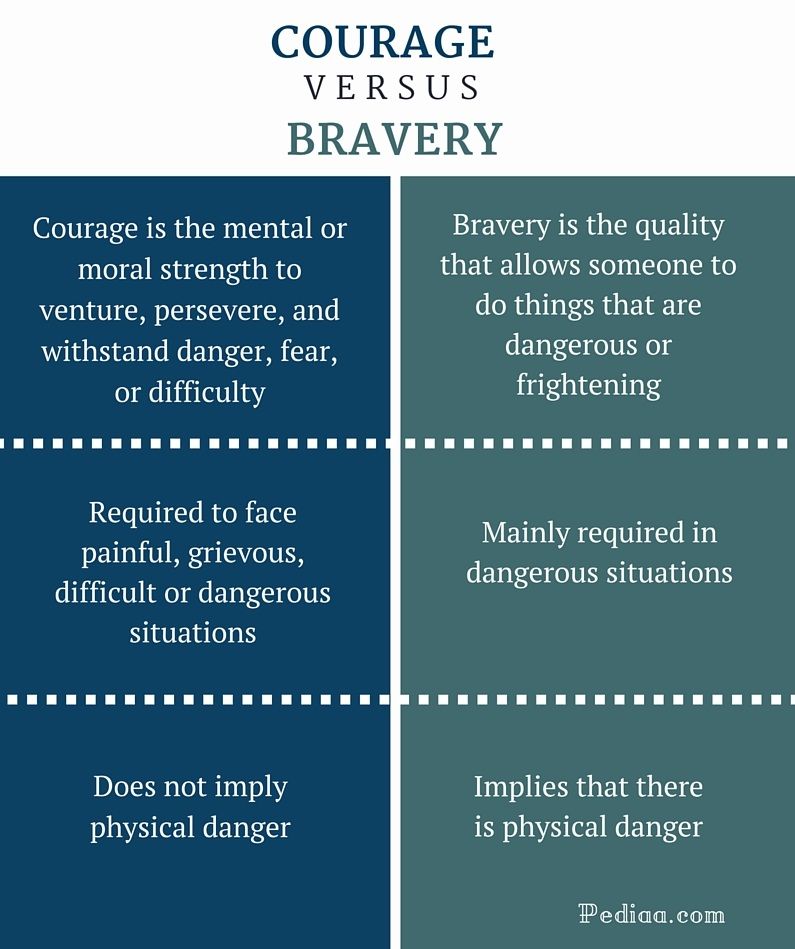 nine0003
nine0003 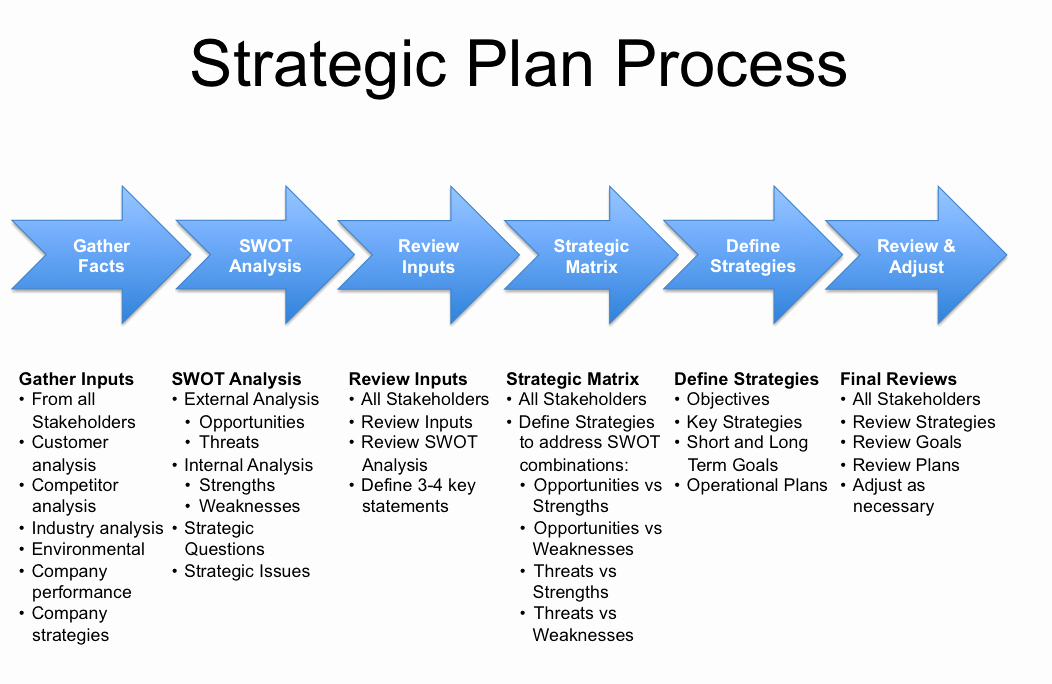
 In terms of FAE reduction, monetary incentives and informing participants that they will be responsible for their own attribution were associated with an increase in accurate attribution. Training also reduces cognitive distortions. Carey K. Morwedge and colleagues (2015) found that study participants who were exposed to one-time learning interventions, such as learning videos and de-distortion games that taught mitigation strategies, showed a significant reduction in committing six cognitive biases at once and up to 3 months. later. . nine0003
In terms of FAE reduction, monetary incentives and informing participants that they will be responsible for their own attribution were associated with an increase in accurate attribution. Training also reduces cognitive distortions. Carey K. Morwedge and colleagues (2015) found that study participants who were exposed to one-time learning interventions, such as learning videos and de-distortion games that taught mitigation strategies, showed a significant reduction in committing six cognitive biases at once and up to 3 months. later. . nine0003  Although cognitive bias modification may refer to alteration of cognitive processes in healthy individuals, CBMT is a growing field of evidence-based psychological therapy in which cognitive processes are modified to alleviate suffering from major depression, anxiety, and addiction. CBMT methods are technology-assisted therapies delivered through a computer with or without physician support. CBM combines data and theory from the cognitive model of anxiety, cognitive neuroscience, and attention models. nine0003
Although cognitive bias modification may refer to alteration of cognitive processes in healthy individuals, CBMT is a growing field of evidence-based psychological therapy in which cognitive processes are modified to alleviate suffering from major depression, anxiety, and addiction. CBMT methods are technology-assisted therapies delivered through a computer with or without physician support. CBM combines data and theory from the cognitive model of anxiety, cognitive neuroscience, and attention models. nine0003 
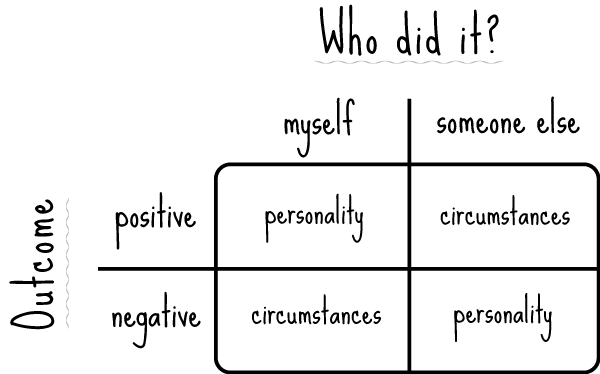 However, these stable levels of bias within individuals can be changed. Experimental participants who watched educational videos and played addiction elimination games showed moderate to large decreases both immediately and up to three months later in the degree of susceptibility to six cognitive biases: anchoring, bias blind spot, confirmation bias, and fundamental attribution error. projection bias and representativeness. nine0003
However, these stable levels of bias within individuals can be changed. Experimental participants who watched educational videos and played addiction elimination games showed moderate to large decreases both immediately and up to three months later in the degree of susceptibility to six cognitive biases: anchoring, bias blind spot, confirmation bias, and fundamental attribution error. projection bias and representativeness. nine0003  Those with higher CRT scores tend to be able to respond more correctly to various heuristic and cognitive tests and tasks. nine0003
Those with higher CRT scores tend to be able to respond more correctly to various heuristic and cognitive tests and tasks. nine0003  nine0003
nine0003 